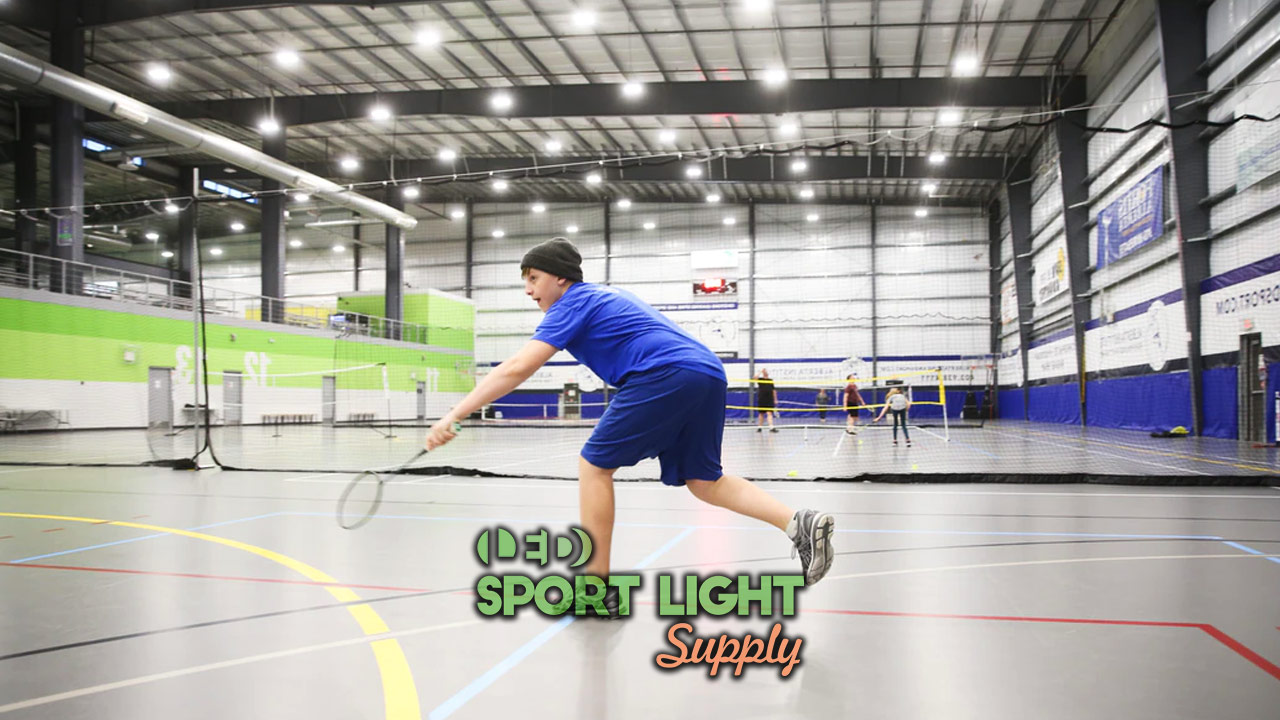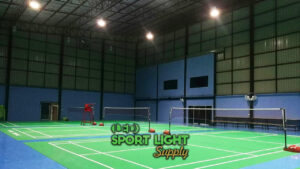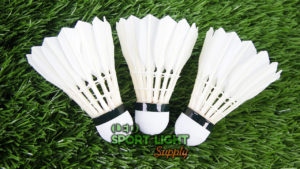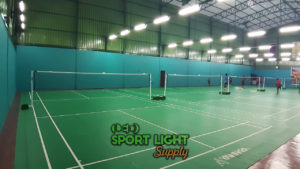Badminton is a popular sport in the world. You can practice it singly or in pairs on a rectangular field (the badminton court) divided by a net. In brief, the game consists of hitting a shuttlecock (or bird) with a racket and making it cross the net.
Most teams play in a badminton hall. That is, a sports facility with one or more indoor badminton courts. Both indoor and outdoor matches require adequate lighting as the games can take place any time, day or night. So, here is a short look into the badminton lighting system.
We are going to see why we need adequate badminton court lighting. As well as what kind of lights you should use or find in indoor and outdoor arenas. You will also read a short summary of the differences that varying light sources provide when playing badminton.
Why do we need badminton court lighting?
1. Lighting for night badminton players
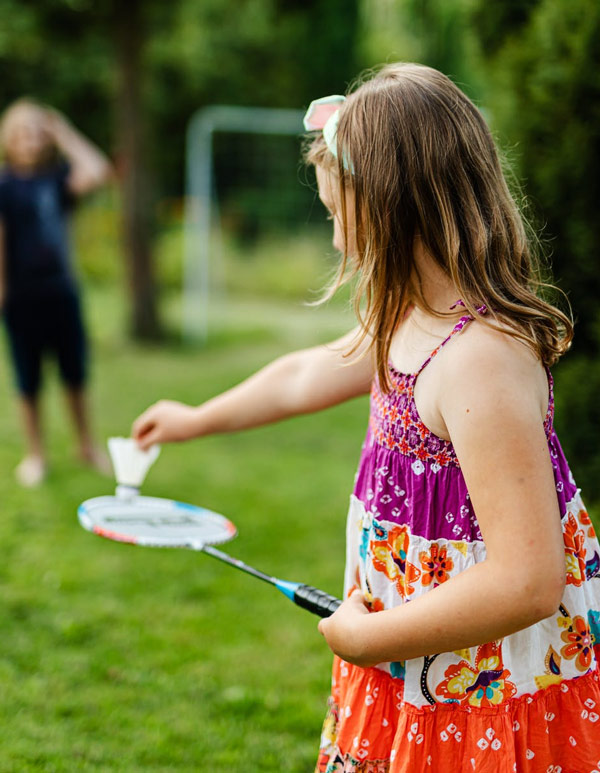 Officially, the British were the first to play badminton in England in the second half of the last century. But the origins of this sport are very ancient. Today, most players, like students or employees, can only do sports at night. So, getting the badminton court lighting can let them do sports at night. In short, the right lights maximize the usage of outdoor badminton court at night.
Officially, the British were the first to play badminton in England in the second half of the last century. But the origins of this sport are very ancient. Today, most players, like students or employees, can only do sports at night. So, getting the badminton court lighting can let them do sports at night. In short, the right lights maximize the usage of outdoor badminton court at night.
One of the strictest badminton rules is that the shuttlecock must not touch the ground. More precisely, a player scores a point when the shuttlecock hits the ground within the boundary lines.
2. Improves badminton players’ vision
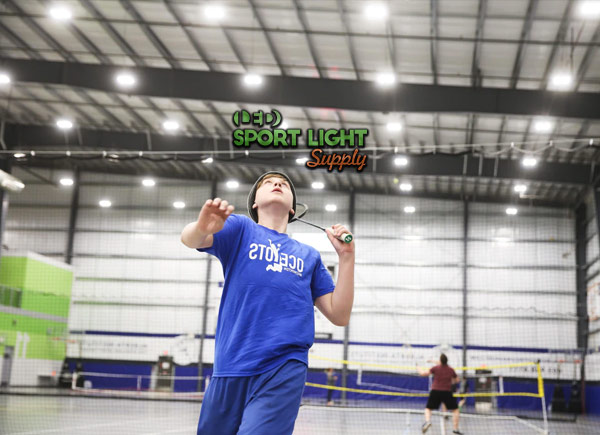 The main judge, or umpire, supervise the match. But expert players learn all sorts of tricks. Often, they act quickly in order to throw the opponent off balance. For example, by using the racket at a sharp angle to hit the bird at the last moment. Proper lighting improves badminton players’ vision. Plus, the umpire can see the fast-moving badminton action.
The main judge, or umpire, supervise the match. But expert players learn all sorts of tricks. Often, they act quickly in order to throw the opponent off balance. For example, by using the racket at a sharp angle to hit the bird at the last moment. Proper lighting improves badminton players’ vision. Plus, the umpire can see the fast-moving badminton action.
3. Best badminton court lighting for televised tournaments
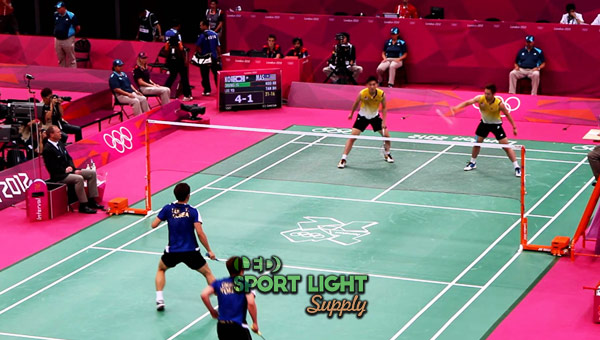 Because of the intense action, proper lighting becomes crucial for televised tournaments. In the past, most players tried to cheat. But new techs like LED lighting and video camera recording solved this kind of problem. A badminton hall owner needs extremely bright lighting to fulfill the lighting requirement. For both fair play and broadcasting.
Because of the intense action, proper lighting becomes crucial for televised tournaments. In the past, most players tried to cheat. But new techs like LED lighting and video camera recording solved this kind of problem. A badminton hall owner needs extremely bright lighting to fulfill the lighting requirement. For both fair play and broadcasting.
Then again, adequate lighting is necessary for the players as much as the spectators in the sports venue. In fact, it provides a comfortable vision and makes sure the sport is attracting more spectators each time.
What kind of lights does the badminton court use?
Today’s badminton uses a precise lighting design. The main goals are to heighten the badminton court contrasts, prevent glare, and provide lighting uniformity. Basically, this sport requires the use of four types of light sources.
So, how do we call badminton court lighting? If you are wondering what the names of the badminton court light sources are, here you go:
- Flood light
- Spot light
- High mast light
- High bay light
1. Flood light
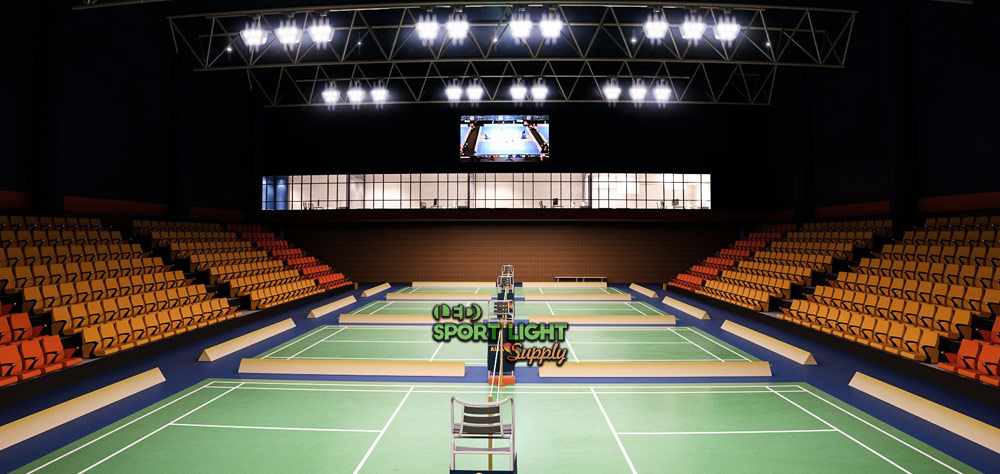
A flood light provides a wide beam angle for close range. In comparison with the other light sources, the beam is larger and diffuse over a larger area as well.
Usually, the lighting standard for flood lights requires a glare rating (GR) below 30. That is, a method detailed in the CIE 112:1994 document to calculate uncomfortable brightness values. The quantity and overall brightness of the light sources must not exceed this technical value. So, in the average badminton hall, you will likely find up to 36 pcs of 100-200 Watt LED flood lights.
Flood light quality can greatly vary according to the level of competition or specific regulation. The artificial lighting systems must comply with the UNI EN 12193 standards. According to most associations, they must prevent glare for players and spectators.
All the flood lights must be equipped with a safety coupling system capable of preventing the lighting body from falling in the event of a release from the supports due to impact. Also, the presence of a shockproof grille is customary.
2. Spot light
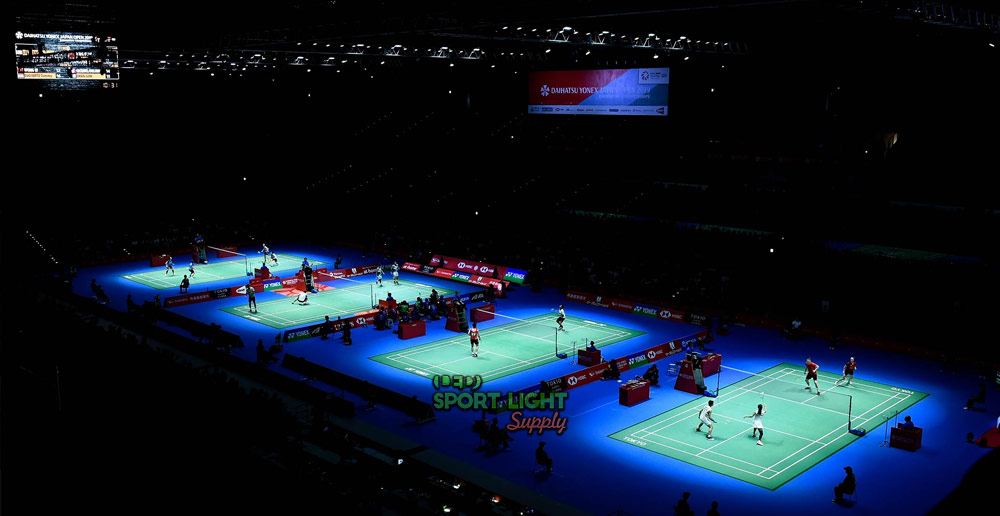
A spot light provides a narrow beam angle for long range. In detail, the beam is smaller just so that you can install it on ceiling corners, mounts, or walls.
Sometimes, a sports facility can install and use spot lights as maintenance lights. From time to time, the lighting system will require repairs and maintenance. Especially to comply with the requirements for televised tournaments.
During this time, spot light can provide adequate lighting to let the players train. Alternatively, they can be used during a match to support the lighting system. At least, as long as the overall illuminance values are within the norm.
Famous sports venues can also use RGB spot lights to create multicolor plays of light before and after the matches. Or during the breaks.
In the average badminton hall, you will likely find at least 4 pcs of 50-200 Watt LED spot lights. Or more, if they use them as maintenance lights.
3. High mast light
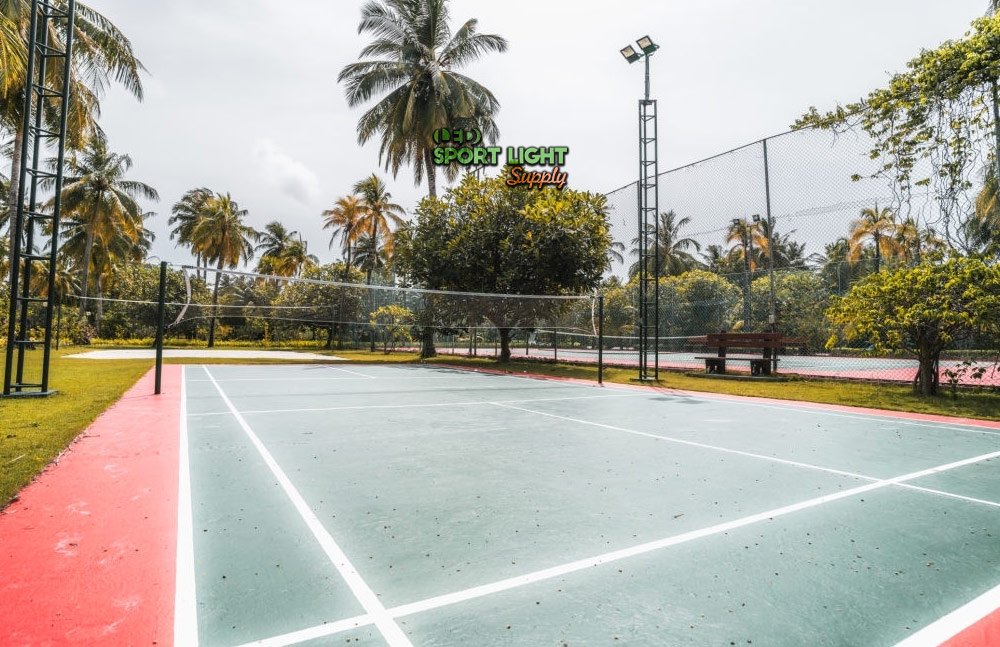
A high mast light for an outdoor badminton court includes a light pole and a light fixture. More importantly, the required authorization to build one can limit the height or other details.
The kind of luminaries and circuit design are at the base of the high mast lighting. Each outdoor badminton court can pose different challenges. For example, what is the soil condition? What other sports will they play on the pitch?
The light pole height varies with the size of the area. For safety reasons, most light poles are no higher than 15 meters.
Only qualified personnel can install and handle the poles. In fact, they adopt suitable lifting means with the aid of appropriately sized bands for the capacity. Moreover, a lighting designer should ensure the height and luminaries do not represent a risk of light pollution.
High mast lights are not eternal. It would be a good idea to periodically check the state of wear of the High mast light protections, whether with a layer of paint or zinc.
Generally, corrosion mainly attacks the interlocking area of the pole in the foundation block. In the case of an advanced and critical state of deterioration, immediate replacement is necessary. But the average life of a light pole ranges between 10 to 20 years.
4. High bay light
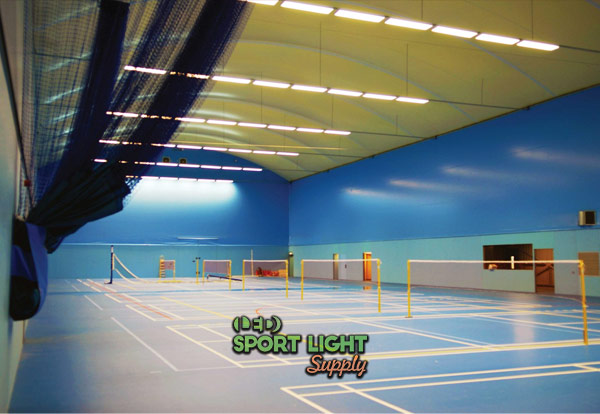 A high bay light for an indoor badminton court usually shines from ceiling supports or mounts. You might have seen one of the most frequently used models, the UFO high bay.
A high bay light for an indoor badminton court usually shines from ceiling supports or mounts. You might have seen one of the most frequently used models, the UFO high bay.
High bay lights must be installed in such a way as to allow the performance of competitive sports and exercise in comfortable, secure, and safety conditions for all users. That includes athletes, competition officials, staff, and spectators, according to the needs related to the level of practice or competition.
For pre-existing systems, high bay lights are amongst the most retrofittable fixtures. In fact, the LED tech adapts to most lighting systems with little or no modification to the electrical system.
Most high bay lights have a wide beam angle. That is, 120-150 degrees. Plus, they can provide a varying color temperature (warm and white light). They also offer an excellent color rendering index (CRI). In short, they faithfully reproduce the colors of an illuminated object.
Several 200 Watt LED High bay lights are in most major sports venues. Clearly, sponsors want well-lit advertisements on the sides of the pitch. Public safety authorities also want public areas well lit. In a large badminton hall, the illuminance level must allow the use of surveillance cameras.
LED VS metal halide VS halogen VS fluorescent. Which is best for badminton court?
While the playing field is usually well-lit, the varying lighting tech could make a difference for the badminton hall owner.
Basically, only one form of artificial light is recommendable for badminton today. That is, LED. LED is the best because of energy saving, long life span, cooler temperatures (no overheating), and other details.
But what about the other types of lamps? In this section, I am going to compare LED with the other types. Each time, you will learn what kind of benefit you get when using LEDs instead of anything else.
1. LED VS metal halide
Metal halide lamps generate heat and need to cool down every time you turn them off. LED lighting does not have such a problem. What is worse, a metal halide lamp emits dangerous UV light. LEDs are safe. So, you need to put a protective layer or filter in front of the metal halide bulb.
Most likely, you will have to change the metal halide lamps at least once a year. Their short life span also means that their luminous efficiency will decrease quickly over time. In other words, in most cases, they require the addition of extra lighting to fulfill the requirements even before you replace them.
2. LED VS halogen
The original model of the good old incandescent bulb appeared in 1879. Today, this type of lighting is obsolete. But the same tech evolved into the halogen lamps. They are like incandescent lights, but they also contain a halogen gas. Normally, iodine.
Halogen lamps have an energy efficiency of 10%. While the overall performance of halogen lamps slightly increases in comparison with its predecessor, this also comes with consequences. For example, the disposal of a halogen lamp must follow a precise recycling procedure. LED is a more innovative tech that further improves on the energy conversion efficiency ratio. In fact, LEDs are up to 53% efficient.
3. LED VS fluorescent
The transition from fluorescent light to LED fixtures should be a crucial intervention in the energy requalification project of any building. For one thing, fluorescent lights take a while to turn on while LED lights turn on instantaneously. Plus, LED lights are two times more efficient than fluorescent equivalents. And lastly, LEDs do not require any maintenance. Instead, fluorescent lights are known for their sudden breakdowns.

